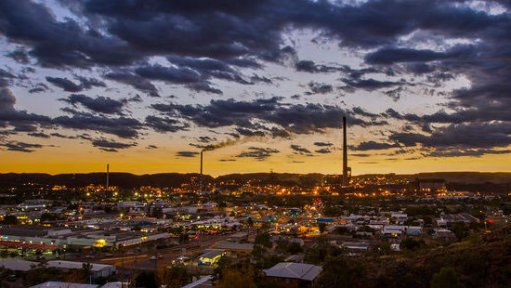Mapping solution wins US health, safety award
Australia-headquartered drone autonomy and mapping expert Emesent’s Hovermap ST has won the metal industry sector category in the 2022 NIOSH Mine Safety and Health Technology Innovation Awards, the company announced on its website last month.
It was chosen by the selection committee in recognition of the Hovermap ST’s contribution to advancing mineworker safety. “A contribution that was proven in an example from Glencore Kidd mine, situated outside Timmins, in Ontario, Canada,” said Emesent.
Hovermap is used by surveyors and geotechnical engineers at Glencore Kidd mine on an almost daily basis to monitor deformation, detect and manage geotechnical hazards within stopes and drifts, and increase their knowledge of the rock mass and ground control conditions. Data is captured using the Hovermap in multiple scanning modes – walking, drone, vehicle, and remote ground robot scans.
“The first time we flew Hovermap into one of our deepest and most inaccessible stopes, we got a complete picture with no shadows. The resultant point cloud data perfectly showed the areas we were concerned about. Hovermap has become the go-to technology for our survey and geotechnical teams as we seek to safely maximise output,” Kidd Operations Mine Technical Services manager Iain McKillip told Emesent.
The awards, held by the US National Institute for Occupational Safety and Health, are presented in conjunction with the National Mining Association and the US Office of Surface Mining Reclamation and Enforcement.
The awards, which are conducted yearly, recognise mines and companies that have made “extraordinary efforts to apply or produce technology to improve processes above and beyond mandatory requirements to improve mineworker safety and health”.
Emesent reported that Hovermap ST was awarded by the selection committee because it exemplified innovative qualities and provided significant advancements to enhance mine safety. Hovermap ST uses light detection and ranging (or LiDAR) data and advanced algorithms to generate accurate three-dimensional point clouds of the scanned environment, as well as to automate drone flight even when GPS is not available.
Mounted to a drone, Hovermap ST is able to fly into inaccessible areas, such as stopes, drawpoints, orepasses and drives, to capture shadowless, high-quality point cloud data that is sent to the operator in real time, while they remain safely away from the face. With thousands of hours of autonomous flight logged by customers, it is the “most proven LiDAR mapping and autonomy solution for GPS-denied environments”, said Emesent.
“Underground mining is inherently dangerous. Reducing as much of that risk as possible through personnel placement and monitoring ground support throughout the mine is imperative to ensure safety,” said Emesent chief revenue officer Jim Stuart.
“With Hovermap ST, we provide mine operators with a means to maintain an accurate and current understanding of the status of their mines. Hovermap ST delivers a fast and accurate method of capturing this information, reducing operational delays. Its autonomy increases personnel safety by removing the need for them to access the more hazardous areas.”
Emesent and Hovermap have gained a solid reputation as safety enablers in other GPS-denied environments. Hovermap was part of the technology used by the team that placed second in the US Defence Advanced Research Project Agency SubTerranean Challenge – a challenge designed to develop robot fleets that can autonomously traverse dangerous, GPS-denied areas and obtain a situational awareness before humans are required to enter.
It is also being used by National Aeronautics and Space Administration’s Jet Propulsion Laboratory in its project exploring the caves in Lava Beds National Monument, in California, with the ultimate aim of exploring the lava tubes on Mars for signs of ancient alien life.
Comments
Press Office
Announcements
What's On
Subscribe to improve your user experience...
Option 1 (equivalent of R125 a month):
Receive a weekly copy of Creamer Media's Engineering News & Mining Weekly magazine
(print copy for those in South Africa and e-magazine for those outside of South Africa)
Receive daily email newsletters
Access to full search results
Access archive of magazine back copies
Access to Projects in Progress
Access to ONE Research Report of your choice in PDF format
Option 2 (equivalent of R375 a month):
All benefits from Option 1
PLUS
Access to Creamer Media's Research Channel Africa for ALL Research Reports, in PDF format, on various industrial and mining sectors
including Electricity; Water; Energy Transition; Hydrogen; Roads, Rail and Ports; Coal; Gold; Platinum; Battery Metals; etc.
Already a subscriber?
Forgotten your password?
Receive weekly copy of Creamer Media's Engineering News & Mining Weekly magazine (print copy for those in South Africa and e-magazine for those outside of South Africa)
➕
Recieve daily email newsletters
➕
Access to full search results
➕
Access archive of magazine back copies
➕
Access to Projects in Progress
➕
Access to ONE Research Report of your choice in PDF format
RESEARCH CHANNEL AFRICA
R4500 (equivalent of R375 a month)
SUBSCRIBEAll benefits from Option 1
➕
Access to Creamer Media's Research Channel Africa for ALL Research Reports on various industrial and mining sectors, in PDF format, including on:
Electricity
➕
Water
➕
Energy Transition
➕
Hydrogen
➕
Roads, Rail and Ports
➕
Coal
➕
Gold
➕
Platinum
➕
Battery Metals
➕
etc.
Receive all benefits from Option 1 or Option 2 delivered to numerous people at your company
➕
Multiple User names and Passwords for simultaneous log-ins
➕
Intranet integration access to all in your organisation


















